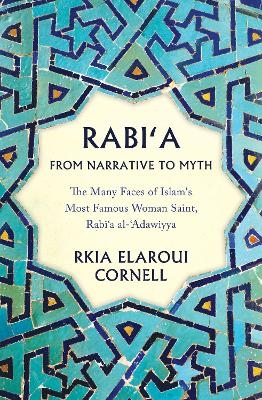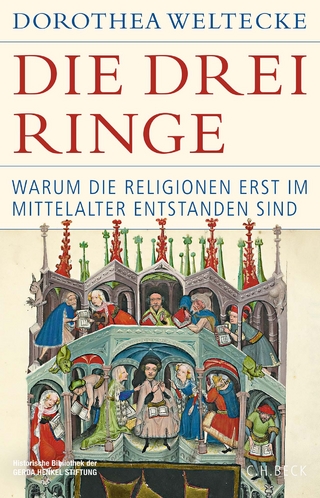
Rabi'a From Narrative to Myth
Oneworld Academic (Verlag)
978-1-78607-521-5 (ISBN)
- Titel z.Zt. nicht lieferbar
- Versandkostenfrei
- Auch auf Rechnung
- Artikel merken
Rabi‘a al-‘Adawiyya is a figure shrouded in myth. Certainly a woman by this name was born in Basra, Iraq, in the eighth century, but her life remains recorded only in legends, stories, poems and hagiographies. The various depictions of her – as a deeply spiritual ascetic, an existentialist rebel and a romantic lover – seem impossible to reconcile, and yet Rabi‘a has transcended these narratives to become a global symbol of both Sufi and modern secular culture.
In this groundbreaking study, Rkia Elaroui Cornell traces the development of these diverse narratives and provides a history of the iconic Rabi‘a’s construction as a Sufi saint. Combining medieval and modern sources, including evidence never before examined, in novel ways, Rabi‘a From Narrative to Myth is the most significant work to emerge on this quintessential figure in Islam for more than seventy years.
Rkia Elaroui Cornell is Professor of Pedagogy and Coordinator of the Arabic program at Emory University in Atlanta, Georgia. She has given numerous lectures and conference presentations on the subjects of Qur’anic exegesis, women in Islam, and language pedagogy.
Introduction: RABI‘A, “THE WOMAN WHO NEVER DIES”
I. The Myth Of Rabi‘a al-‘Adawiyya As A Master Narrative
II. Key Premodern Sources and Modern Works on Rabi‘a al-‘Adawiyya
III. What Is a Myth?
IV. The Plan of this Work
Chapter 1 RABI‘A THE TEACHER
I. Who Was the “Real” Rabi‘a?
a. Early Sources for the Historical Rabi‘a
b. Alleged Students and Associates of Rabi‘a al-‘Adawiyya
II. Rabi‘a in the Earliest Sources
a. Rabi‘a the Arab
b. Rabi‘a the Leader
c. Rabi‘a the Sunni Muslim
d. Rabi‘a the Eloquent
III. Rabi‘a the Teacher and the Culture of Adab in Early Islam
a. Rabi‘a and Sufyan al-Thawri
b. Ta’dib: The Art of Character Formation
c. Taʼdib and the “Manly” Virtues: Muruwwa and Hilm
d. Rabi‘a’s Way of Ta’dib
Chapter 2 RABI‘A THE ASCETIC
I. Conceptualizing Asceticism in Early Islam
a. The World/Nonworld Dichotomy
b. The Problem of Asceticism as a Theoretical Category
II. Terms of Early Islamic Asceticism
a. Zuhd (Renunciation)
b. Wara‘ (Ethical Precaution)
c. Nusk (Ascetic Ritualism)
d. Faqr (Poverty)
III. Traditions of Women’s Asceticism in Basra
a. The Legacy of ‘A’isha
b. The School of Mu‘adha al-‘Adawiyya and Instrumental Asceticism
c. The Weeping Women (al-Bakiyat) of Basra
IV. The Asceticism of Rabi‘a and Her Circle
a. Rabi‘a’s Alleged Students and Associates
b. From Instrumental Asceticism to Essential Asceticism
Chapter 3 RABI‘A THE LOVER
I. From Historical Representation to Cultural Icon
II. Asceticism and Love Mysticism in Early Islamic Basra
a. From Asceticism to Love Mysticism
b. Love of God in the Qur’an and Hadith
c. The Ascetic Lovers of Basra
d. The Question of Rabi‘a’s Celibacy
III. Rabi‘a the “Muslim Diotima?”
a. The “Incognito Presence” of Plato’s Symposium
b. Rabi‘a the Lover in Abu Talib al-Makki’s Qut al-Qulub
IV. Rabi‘a the Love Poet
a. The Poem of the Two Loves
b. The Poem of the Intimate Gift
Chapter 4 RABI‘A THE SUFI
I. The Lady Reconsidered: Can We See the Real “Rabi‘a the Sufi”?
II. Locating Rabi‘a the Sufi: What Was A “Sufi” in Eighth-Century Islam?
III. The Heart as a Metaphor in Early Islamic Mysticism
a. Scriptural Antecedents
b. Possible Paths of Transmission
c. The Metaphor of the Heart for Rabi‘a al-‘Adawiyya and Her Contemporaries
IV. Rabi‘a the “Knower of God”
Chapter 5 RABI‘A THE ICON (I): THE SUFI IMAGE
I. Rabi‘a As A Literary Figure: Myth, Icon, and the “Reality Effect”
II. From Visage to Vita: ‘Attar’s Outline of the Rabi‘a Myth
a. Composing the Background: ‘Attar’s Hagiographic Predecessors
b. ‘Attar’s Portrayal of Rabi‘a al-‘Adawiyya in Tadhkirat al-Awliya’
III. Every Picture Tells a Story: ‘Attar’s Emplotment of Rabi‘a’s Vita
IV. Postscript: Where is Rabi‘a Buried?
Chapter 6 RABI‘A THE ICON (II): THE SECULAR IMAGE
I. From Religious to Secular Narratives
II. Rabi‘a the Existentialist
III. Rabi‘a the Film Icon
IV. Postscript: Rabi‘a, The Phantom of the Television Series
Epilogue RABI‘A, THE MYTH AND THE NARRATIVE
Bibliography
I. Sources in Arabic and Persian
II. Sources in European Languages
Index
| Erscheinungsdatum | 07.12.2018 |
|---|---|
| Sprache | englisch |
| Maße | 153 x 234 mm |
| Themenwelt | Sachbuch/Ratgeber ► Geschichte / Politik ► Allgemeines / Lexika |
| Geschichte ► Teilgebiete der Geschichte ► Religionsgeschichte | |
| Geisteswissenschaften ► Religion / Theologie ► Islam | |
| Sozialwissenschaften ► Soziologie ► Spezielle Soziologien | |
| ISBN-10 | 1-78607-521-0 / 1786075210 |
| ISBN-13 | 978-1-78607-521-5 / 9781786075215 |
| Zustand | Neuware |
| Haben Sie eine Frage zum Produkt? |
aus dem Bereich


